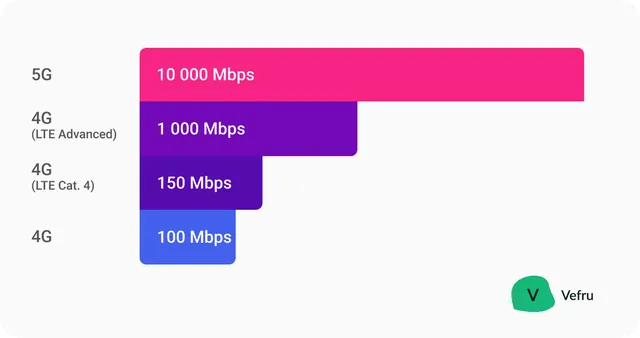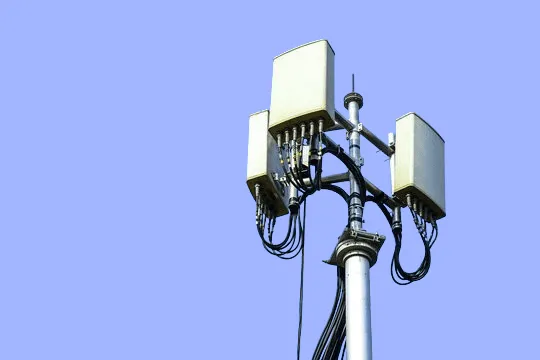5G Article Contents
Those of us who still remember the transition from 3G to 4G (LTE) might feel that searching for carriers and phones that support 5G is a clear choice. Especially when we look at the maximum theoretical speeds of these two technologies. However, it's not as simple as it may appear at first glance.

Technology speed comparison
5G fundamentally differs from 4G
4G and all previous network generations used standard cell towers and had relatively large coverage. 5G technology with its millimeter waves has incredible maximum download speeds (10,000 Mbps) and very low latency (1 ms), but also very limited range.
If you want to be "in range," you must be relatively close and preferably have direct line of sight to the transmitter, otherwise 5G connection speed drops dramatically, even below 3G levels (7Mb/s).
Therefore, 5G transmitters are only being built in very densely populated areas where the higher number of possible connected devices compared to 4G is also beneficial.

Example of 5G "small cell" transmitter
What actually limits 4G (5G) speed?
Today's phones with 4G and 4G+ (LTE Advanced) can download at speeds of 150 to 300 Mbps. This speed is more than sufficient for the vast majority of tasks you can do on your phone. For example, watching 4K video on YouTube requires 20 Mbps.
Of course, there are other factors that limit download speed. The first one you might think of is signal strength. Much more important factors, however, are network congestion and artificial speed throttling by the carrier.
You can notice network congestion if you're in a large building with many people, or at a concert, when many people are on the same band and speed decreases.
Connection speed throttling by carriers is something that affects almost all plans and packages. The most speed-limited are usually the so-called "unlimited data plans." There, carriers like to throttle speed and thus actually limit how much data you can use, even if you were downloading all day. For this reason, it's always important to read the details of the plan or eSIM packages, where the carrier must specify the speed to which the plan or package is limited. And don't just look at marketing plan names with "4G" and "5G".
Am I really on 5G?
The 5G icon on your phone doesn't necessarily mean you're actually using a 5G network. Usually it only signals network availability nearby, but connection often happens through LTE, especially with NSA (Non-Standalone) networks that combine 5G with LTE. Phones thus appear to be connected to 5G, but actual speed may only be at LTE level. The 5G indicator is more of a rough guide and doesn't represent a reliable indicator of actual connection.
What does this mean?
When choosing a plan or eSIM data package, it's crucial to check whether and how the carrier limits speed. 5G support may rather indicate how much the carrier invests in network and coverage, or it might be an advantage if you're close to a transmitter.
If you're choosing a new phone, there's no significant reason yet to limit yourself only to 5G models. If you're interested in technology or want to ensure your phone won't be outdated in a few years, choosing a 5G phone certainly won't be a mistake. Plus, you can also take advantage of their frequent benefit – larger battery capacity.

What is eSIM?
eSIM allows you to use a digital SIM card instead of a traditional plastic one. This enables you to purchase a SIM card online for the country you're traveling to.
The most well-known eSIM providers on the market are Airalo, Holafly, eSIM4Travel, Yesim, Saily and others.
Frequently asked questions about eSIM:
- Does my phone have eSIM?
- How to add eSIM to iPhone or Samsung?
- How to install eSIM on an older phone?
- What are the most affordable and best phones with eSIM support?

How to compare eSIM?
Here you can compare eSIM data packages for more than 170 countries, such as UK, USA, Egypt and others. And that for any duration and amount of data.
Along with additional information, such as provider ratings and whether the website is available in Czech.
Compare all eSIMs
Why can you trust Vefru?
Founders František and Jan experienced problems with mobile data every time they traveled outside the EU. As technology enthusiasts, the idea of traveling abroad without a data connection or risking truly insane roaming fees was unacceptable to them. Regardless of how adventurous the story of walking across Toronto on a winter night without an online map might be, it's not something they would want to repeat.
After the emergence of eSIM and later eSIM travel data package providers, they learned a lot about the technology and industry and decided to share their findings and the comparison tool they created for themselves with others. It now contains more than 10,000 updated eSIM mobile data packages from the most popular providers for more than 170 countries around the world.
Every time you read a guide on Vefru, it is created in the same way the author would research the topic themselves. From contacting locals about the best network operators, to recommending the most advantageous plans for what you really need, to technical guides on how to create a QR code for eSIM or how to troubleshoot eSIM issues. Most articles are created based on topics that the authors themselves have dealt with and for which they found the best solutions.
Technology experts
instead of copywriters
We test everything we
write about
We compare 10 thousand
eSIM data packages






